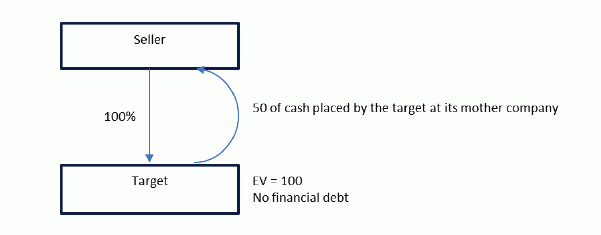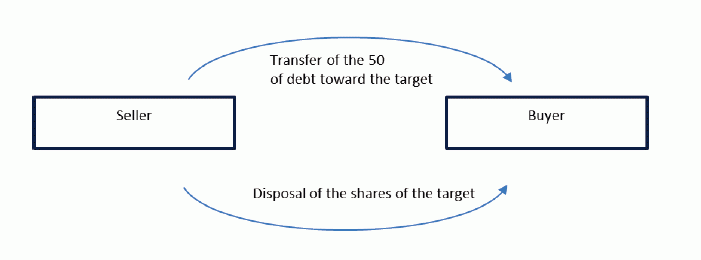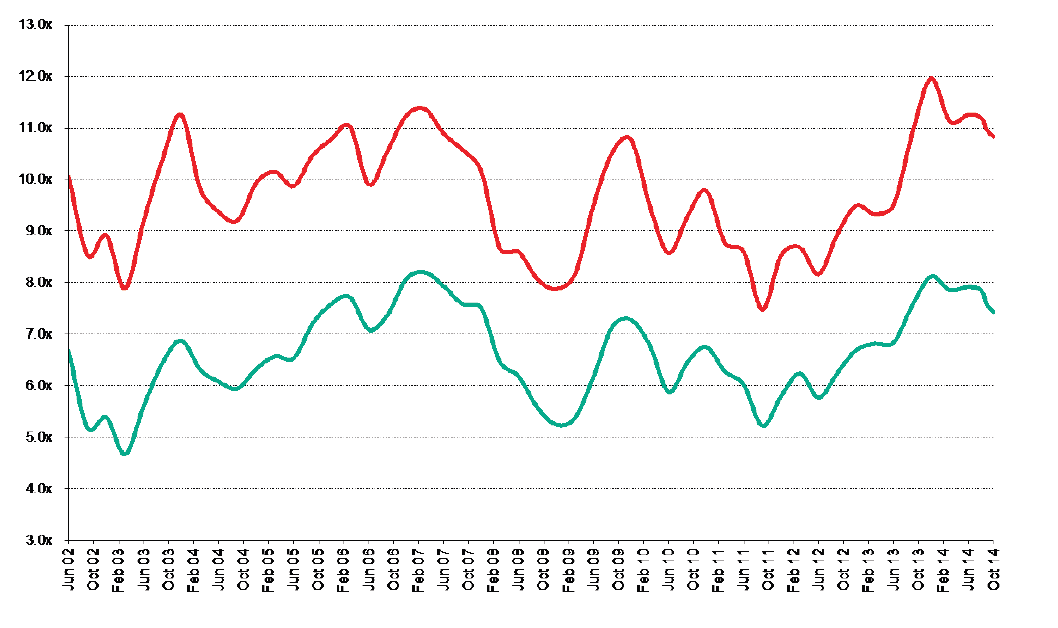Letter number 85 of December 2014
- TOPIC
- STATISTICS
- RESEARCH
- QUESTIONS & COMMENTS
News : The new 2014 edition of the Vernimmen
We are pleased to announce that the fourth edition of The Vernimmen is now available from all good bookstores and on-line retailers.
With thousands of copies of the latest edition sold, Corporate Finance, Theory and Practice has emerged as one of the most popular financial textbook, thanks to its four unique features:
• A balanced blend of theory and practice: authors hold academic positions at top ranking universities and business schools and are also investment banker, private equity investor or sit on the boards of listed and unlisted companies.
• A presentation of concepts that explain situations, followed by a discussion of techniques in a direct and succinct style.
• Content enriched by the www.vernimmen.com website, which with 1,000 daily visitors, is one of the leading finance teaching sites worldwide.
• Free monthly updates on finance through The Vernimmen.com Newsletters, with over 70,000 subscribers.
For this edition two new chapters were created. The first one (chapter 39, Implementing a debt policy) gives a practical view on how corporates should structure debt. Illustrated with a concrete example, this chapter gives some clear guidelines on dos and donts for the CFO to optimize the financial debt of the firm. The summary of this chapter is available here.
As an increasing proportion of our students choose once graduated (or even before for some of them) to create their business, we thought it would be a good idea for this edition to propose a new chapter (chapter 40) on the financial aspects of creating a startup. With this new chapter the Vernimmen now covers all the steps in the life of a company. The summary of this chapter is available here.
We have also done a major updating job to create a tool that is accurate, reliable, comprehensive and relevant. We have included the very latest accounting standards (change in IFRS rules for consolidation of subsidiaries), most statistics and graphs are from mid-2014 or end 2013, the latest innovations in financial practice are discussed and the latest financial theories are presented.
To make sure that you get the most out of your Vernimmen, each chapter ends with a summary, a series of problems and questions (827) (solutions provided). For those interested in exploring the topics discussed in greater depth, there is an end-of-chapter bibliography and suggestions for further reading, covering fundamental research papers, articles in the press and published books. A large number of graphics and tables (over 100) have been included in both the appendix and in the body of the text which can be used for comparative analyses. There are over 3,500 entries in the index.
To have a look on the contents of the 2014 edition of the Vernimmen click here and to buy the 2014 edition of The Vernimmen, click here
What they said about 2014 edition of The Vernimmen:
I discovered finance with “The Vernimmen” about 30 years ago. Since then the different versions have accompanied me throughout my career and throughout the world. Not only was the alignment of the successive editions looking good in my different offices but I must confess I have opened and cherished each of them. Whether an investment banker, a CFO in a universal bank or more simply a world banker...
Bertrand Badre, Managing Director and CFO of The World Bank
I opened my first Vernimmen in 1982. After having spent just a few weekends reading it, I felt better equipped for my role in financial management at Paribas. Now at Apax, the Vernimmen remains my companion in my search for value creation (key in the private equity industry).
Monique Cohen, Associated Director, Apax Partners
Vernimmen's Corporate Finance is an outstanding clear and complete manual, a wonderful merger of practice and theory. Its coverage of the market aspects of corporate finance distinguishes its content, but its treatment of all the material makes it essential reading for the student, financier or industrialist.
Howard Jones, Senior Research Fellow in Finance at Saïd Business School, University Of Oxford
The book itself covers all the important techniques that a financial manager must have in his repertoire of tools. The exposition is clear and concise and, most importantly, relies on commonsense reasoning throughout. This is not a book with obscure formulae, yet is still rigorous and at the same time a model of clarity.
Richard Roll, Joel Fried Professor Of Applied Finance at UCLA Anderson
News : The treatment of the target's cash in acquisitions
The value of an asset lies in its generation of cash so its ability to generate cash flows will always be an attractive feature. Surprisingly, the same cannot always be said for the “stockpile” of cash accumulated on the balance sheet!
Whether they are considering a stock market investment or the acquisition of a company on the private market (M&A), investors generally believe that if the target that they are studying has a large amount of cash on its balance sheet, this is more of a drawback than an advantage.
Accordingly, investors may be reluctant to “buy” cash, and this for several reasons[1]:
- Cash left at the disposal of management may be badly used, for example invested in projects with a negative NPV rather than returned to shareholders (this is the basis of the theory of Free Cash Flow advanced by Jensen in 1988).
- The investor may quite simply believe that the cash would be better used in another investment rather than remaining in the target’s bank account.
- It may be legally complicated to pay the cash out to the shareholder. Because some countries have exchange control (Brazil, China, etc.) it makes the process of repatriating cash generated by a foreign subsidiary complex and lengthy (and sometimes impossible). In such cases, we refer to trapped cash. Moreover, the target may not have sufficient accounting reserves to pay out a dividend.
- The tax regime governing the repatriation of cash may be dissuasive. This is the very problem that US groups have to deal with and that has generated a wave of M&A activity dubbed “tax inversions”[2].
- Finally, even if the cash can be easily paid out without any tax impact, the acquisition of a company with a comfortable cash cushion requires overfunding which can turn out to be costly and complicated. There is no doubt that the interest earned on cash will be less than the cost of financing which means that the buyer will be saddled with a transformation cost. Finally, it will be necessary to negotiate with lenders, the possibility of early repayment of a part of the debt corresponding to the cash of the acquired company(ies).
For all of these reasons, investors often insist on a discount on cash held by the target. So, contrary to the theory, we no longer observe
Value of equity = enterprise value – financial debt + cash
But
Value of equity = enterprise value – financial debt + discounted cash – trapped cash
So, in order to optimise the sale of a company with a large amount of cash on its books, this issue must be anticipated. There are several options for avoiding this discount:
- Get the cash flowing back to the parent company by paying dividends, share buybacks or capital reductions. These transactions must be carried out with a certain degree of anticipation in order to ensure that the cash flows back through the different echelons of the group. The payment of dividends will require the different companies to have sufficient reserves to pay out.
- When the cash is invested by the subsidiaries through a cash pooling arrangement, the seller can propose to the buyer to transfer to him the debts that the entity at the head of the cash pool owes to the subsidiary(ies) to be sold.
Let’s take the example of a target company valued by a buyer on the basis of an enterprise value of 100 and which has cash of 50 held by its parent company.
The value of the shares in the target is then, theoretically, 150 (100 of enterprise value and 50 of cash). But the buyer may be reluctant to acquire so much cash (which here amounts to 50% of the enterprise value).
The simplest solution would be for the seller to pay a dividend before the sale but if this is not possible, the seller could suggest to the buyer:
- That it acquires the shares in the target for 150
- To get the seller to transfer debt towards the target, in exchange for payment by the seller of 50 (a payment is required for the transfer of a liability).
- If both transactions are combined, the buyer will pay 100 for the shares and the debt owed to the target.
This transaction allows to replicate, at the buyer, the cash pool that was in place in the selling group.
Statistics : EV/EBIT and EV/EBITDA multiples for the top listed European groups
EV/EBIT and EV/EBITDA multiples shown below are computed on expected EBIT (red curve) and EBITDA (green curve) by the Business Valuation Team of BNP Paribas and exclude companies in the oil & gas and in the financial sector.
Over the last 12 years, the average EV/EBIT multiple is 9.7 and the average EV/EBITDA multiple is 6.7.
Research : The determinants of financial leverage in LBOs
With Simon Gueguen – Lecturer-researcher at the University of Paris Dauphine
Decisions taken by financial directors of listed companies relating to financial leverage are rare. Sometimes, they carry out proactive increases in debt in order to finance new projects [1]. Such cases are, however, exceptional. Most often, a target level, in line with the characteristics of the company, is aimed at [2].
The case of leveraged buyout (LBO) funds is different. Their managers are required to take more frequent debt-related decisions than any other player in the world of business. Nevertheless, until now, there have been very few empirical studies on the determinants of debt levels in LBOs. The study that we present this week [3] sheds interesting light on this issue and shows that these determinants are not the same for listed companies. This empirical work covers a sample of 1,157 LBOs (mainly US and European) between 1980 and 1998.
From a theoretical standpoint, there are two major opposing viewpoints. The first is that of the famous theorist Michael Jensen [4]. Private equity funds are more efficient in taking decisions than listed companies, for reasons of governance (concentrated shareholder base with fewer agency problems, managers highly incentivized by performance, etc.). According to this viewpoint, choices of capital structure for these funds result from a calculation of optimization between the advantages of debt (especially tax breaks) and the costs linked to the risk of financial stress. The structure chosen then depends, as in the case of listed companies, on the target’s debt capacity – sector, tangibility of assets, volatility of cash flows. Even in the case of greater efficiency of private equity funds, we should find a strong link between the financial leverage of companies under LBO and those of comparable listed companies (same sector, same geographical region). This is not confirmed by the study that we present, which finds no statistical link between the debt of listed companies and that of companies under LBO. It seems that the latter follow their own system of logic.
The second more recent viewpoint considers that private equity funds use their privileged access to the debt market in order to take out debt at the best time (when debt is cheap) and to take advantage of the cost difference with equity. In this case, the determinants of the capital structure of targets are no longer to be found in the intrinsic characteristics of the company but in market conditions. The study supports this theory: the risk premium on the loan market[5] appears to be the main determinant of financial leverage of companies under LBO.
Although this second viewpoint is supported by the data from the study, one question still remains open – that of the link between the capital structure chosen and performance. It is possible that managers of LBO funds do perform particularly well in their choices of capital structure and use cheap debt in order to improve their funds' returns. In this case, the performance of funds should be better when the financial leverage is higher.
But specific agency problems may arise: performance incentives combined with limited responsibility in the event of loss may incite managers of LBO funds to take too many risks [6] . In this case, the debt market may play a disciplinary role. When this market is easy and the rates are low, discipline no longer works and LBO funds tend to overinvest and pay too much for targets. In the sample studied, Axelson et alii in fact find that when financial leverage is high, the price paid by the target increases and, more importantly, the performance of the fund decreases. This is contrary to the predictions of Modigliani Miller as well as empirical observations on listed companies.
In summary, Axelson et alii empirically hold that:
- The capital structure of LBO funds does not depend on the characteristics of the target, but on the situation of the debt market;
- Managers of LBO funds use periods when debt is cheap in order to overinvest and pay too much for targets, as a result of an agency problem.
It is still too early to draw any definitive conclusions on the capital structure of LBOs. Other empirical studies are needed. But is seems to be confirmed that, through their mode of governance, these funds make choices relating to their capital structure that differ from those made by listed companies.
[1] See the vernimmen.com newsletter n°77, October 2013.
[2] See chapter 35 of the Vernimmen.
[3] U.AXELSON, T.JENKINSON, P.STROMBERG and M.S.WEISBACH (2013), Borrow cheap, buy high? The determinants of leverage and pricing in Buyouts, Journal of Finance, vol.68, pages 2223 to 2267
[4] M. JENSEN (1989), Eclipse of the public corporation, Harvard Business Review
[5] Measured as the difference between the Merrill Lynch High-Yield index and the U.S. LIBOR.
[6] This theory is developed by the same U.AXELSON, P.STROMBERG and M.S.WEISBACH (2009), Why are buyouts levered? The financial structure of private equity firms, Journal of Finance, vol.64, pages 1549 to 1582.
Q&A : Why do derivatives make provision for a cash or physical settlement when they fall due?
Derivatives (options, futures) on commodities (oil, potatoes, steel, etc.) may give rise to settlement on maturity in cash (positive or negative financial compensation between the exercise price and the price of the underlying asset) or to settlement in kind (effective delivery of the product in exchange for payment). Both of these methods of settlement-payment have advantages.
Settlement in cash means savings on delivery costs of voluminous physical products and also enables players to carry out hedging operations in a manner that is more fluid. Market liquidity is then increased because the market is open to operators which do not wish to speculate on the product's performance, but (definitely) do not wish to acquire the goods/merchandise at term. These markets, if they function correctly, enable firms wishing to hedge against risk to access cash markets, partly thanks to these players.
Physical settlement-delivery makes it possible to carry out an arbitrage between the financial product and the physical acquisition of the goods/merchandise. Accordingly, this reduces the risk of market manipulation and of the disconnection of the price of the derivative and the price of the underlying physical asset. The efficiency of these markets is then theoretically guaranteed (in as far as the market for the underlying asset is itself sufficiently liquid).
Nevertheless, physical delivery means that the specific parameters of this delivery need to be set in advance (exact quality of product, place of delivery, etc.). These specific parameters make the delivery less than optimal for the company carrying out the hedging (because the underlying product is not exactly what was desired, because the standardised date does not correspond to the supply timetable, or because the place of delivery increases transport costs). Accordingly, even in cases where physical delivery is possible, the acquirer of a derivative product may not necessarily opt for delivery in kind or (which is identical), will sell the product before its maturity date.



